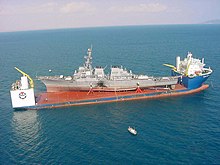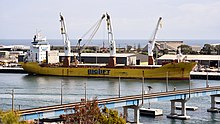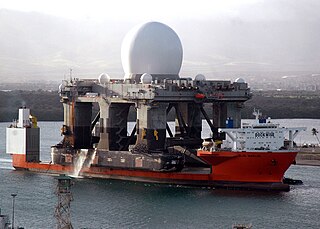
Blue Marlin and her sister ship MV Black Marlin compose the Marlin class of semisubmersible heavy-lift ships operated by Dockwise Shipping of the Netherlands. Designed to transport very large, semisubmersible drilling rigs above the transport ship's deck, she is equipped with 38 cabins to accommodate 60 people, a workout room, sauna and swimming facilities, and a secure citadel for protection against pirate attacks.
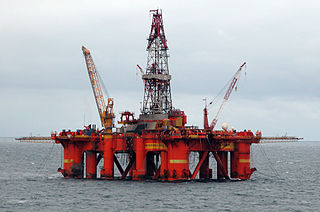
A semi-submersible platform is a specialised marine vessel used in offshore roles including as offshore drilling rigs, safety vessels, oil production platforms, and heavy lift cranes. They have good ship stability and seakeeping, better than drillships.

A platform supply vessel (PSV) is a ship specially designed to supply offshore oil and gas platforms and other offshore installations. They typically range from 50 to 100 metres in length and are distinguished by the large open deck area used to store supplies and house equipment and to allow for efficient loading and offloading. The primary function for most of these vessels is logistic support and transportation of goods, tools, equipment, and personnel to and from their destination.
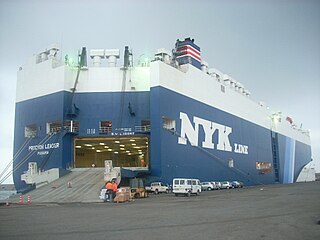
Roll-on/roll-off ships are cargo ships designed to carry wheeled cargo, such as cars, motorcycles, trucks, semi-trailer trucks, buses, trailers, and railroad cars, that are driven on and off the ship on their own wheels or using a platform vehicle, such as a self-propelled modular transporter. This is in contrast to lift-on/lift-off (LoLo) vessels, which use a crane to load and unload cargo.

Mighty Servant 2 was a 29,000-ton semi-submersible, heavy-lift ship operated by Dockwise. The ship drew worldwide attention in 1988 for transporting the mine-damaged USS Samuel B. Roberts from Dubai to Newport, Rhode Island.

A crane vessel, crane ship, crane barge, or floating crane is a ship with a crane specialized in lifting heavy loads, typically exceeding 1,500 t for modern ships. The largest crane vessels are used for offshore construction.

Mighty Servant 3 is a 27,000-ton semi-submersible heavy lift ship. Its deck is 40 by 140 m. The vessel was built in 1984 by Oshima Shipbuilding Co. Ltd. in Ōshima, Japan, for Dutch shipping firm Wijsmuller Transport, which merged in 1993 with Dock Express Shipping to become Breda-based offshore heavy lifting group Dockwise Shipping B.V.
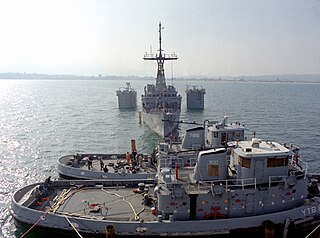
Mighty Servant 1 is a 29,000-ton heavy-lift ship capable of carrying very large vessels and offshore platforms. Built for Dutch shipping firm Wijsmuller Transport, which merged in 1993 with Dock Express Shipping to become Breda-based offshore heavy lifting group, Dockwise Shipping B.V. Mighty Servant 1 carried structures such as oil rigs and floating drydocks. Originally 40 m (130 ft) wide, she was increased to 50 m (160 ft) in 1999 to lift the production rig Petrobras 36 or P36.
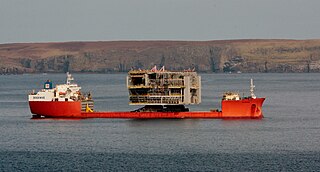
In transportation, heavy lift refers to the handling and installation of heavy items which are indivisible, and of weights generally accepted to be over 100 tons and of widths/heights of more than 100 meters. These oversized items are transported from one place to another, then lifted or installed into place. Characteristic for heavy-lift goods is the absence of standardization, which requires individual transport planning.
Yacht transport is the shipping of a yacht to a destination instead of sailing or motoring it. Yacht transport is an alternative to the traditional passaging to reach desired destinations around the globe. Transport when compared to passaging is cost-effective, safer and improves availability.
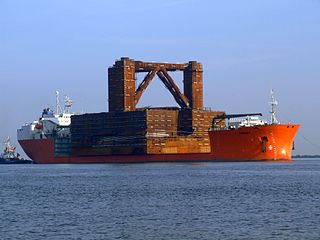
MV Target is a semi-submersible heavy transport ship, built by Brodosplit in Yugoslavia.
Dockwise was a Netherlands-based holding company in the marine transport industry. It was acquired by Boskalis in 2013 and was merged into the Boskalis brand name in 2018.
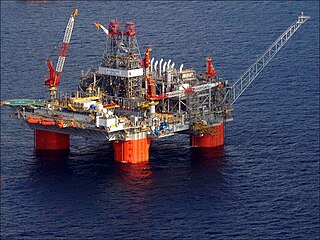
Thunder HorsePDQ is a BP plc and ExxonMobil joint venture semi-submersible oil platform on location over the Mississippi Canyon Thunder Horse oil field, in deepwater Gulf of Mexico, 150 miles (240 km) southeast of New Orleans, moored in waters of 1,840 metres (6,040 ft). The "PDQ" identifies the platform as being a Production and oil Drilling facility with crew Quarters.

SSCV Hermod was a semi-submersible crane vessel operated by Heerema Marine Contractors.
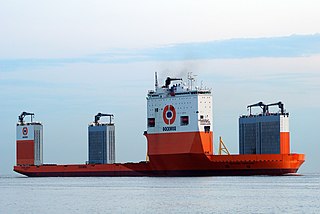
BOKA Vanguard is a semisubmersible heavy-lift ship owned and operated by Dockwise B.V. Dockwise Vanguard is the largest vessel of her type ever built, and is able to carry cargoes up to 110,000 tonnes. Dockwise Vanguard was designed to move offshore oil and gas facilities, but can also carry other ships and act as an offshore dry-dock facility.
A semi-submersible naval vessel is a hybrid warship, that combines the properties of a surface ship and submarine by using water ballast to partially immerse and minimize its above-waterline profile, thereby improving its stealth characteristics when in hostile waters. The USS Monitor was an antecedent to such craft with its low-profile deck and gun turret. Russian and North Korean semi-submersible naval vessels evolved from torpedo boats and special forces boats that could partially submerge to perform their missions. The US Navy SEALs use such vessels for clandestine special forces actions. Efforts to embody advantageous surface-ship characteristics into submarines have not been widely adopted.
The Chinese float-on/float-off ship Donghai Island is the first unit of a class of very little known naval auxiliary ship currently in service with the People's Liberation Army Navy (PLAN). The exact type remains unknown, and only a single unit of this class have been confirmed in active service as of 2020s, with pennant number 868. The float-on/float-off capability of the Donghai class is achieved via its semi-submersible hull design. This ship has received NATO reporting name Modified Hansa Sonderberg class, because it is derived from the Hans Sonderberg-class anchor handling tug supply vessel designed specifically for heavy-lifting and transporting large and heavy equipment such as oil rigs, and Donghai Island performs similar functions.

USS ABSD-5, later redesignated as AFDB-5, was a nine-section, non-self-propelled, large auxiliary floating drydock of the US Navy. Advance Base Sectional Dock-5 was constructed in sections during 1943 and 1944 by the Chicago Bridge & Iron Company in Morgan City, Louisiana for World War II. With all nine sections joined, she was 825 feet long, 28 feet tall, and with an inside clear width of 133 feet 7 inches. ABSD-5 had two traveling 15-ton capacity crane with an 85-foot radius and two or more support barges. The two side walls were folded down under tow to reduce wind resistance and lower the center of gravity. ABSD-5 had 6 capstans for pulling, each rated at 24,000 lbf (110,000 N) at 30 ft/min (0.15 m/s), 4 of the capstans were reversible. There were also 4 ballast compartments in each section.
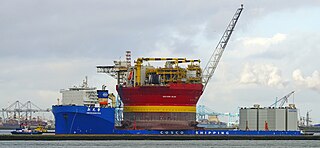
MV Xin Guang Hua is a semi-submersible heavy-lift ship operated by COSCO Shipping. She is the largest Chinese vessel of her type and the second-largest in the world, exceeded only by BOKA Vanguard.
Ocean development refers to the establishing of human activities at sea and use of the ocean, as well as its governance.
